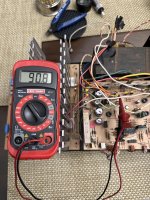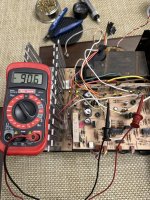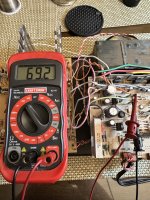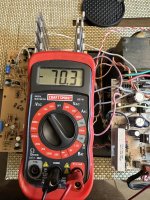A "Pro" repairing such an amp would not start without a signal generator and an osciloscope.
This is the "proper" way. Anyway, this amp and this fault are so simple a voltmeter should do.
An osciloscope is like a voltmeter on speed, but not needed if the full rail voltage is at the output.
It is like searching for an elephant in your living room. You can't miss it.
This is the "proper" way. Anyway, this amp and this fault are so simple a voltmeter should do.
An osciloscope is like a voltmeter on speed, but not needed if the full rail voltage is at the output.
It is like searching for an elephant in your living room. You can't miss it.
Last edited:
First problem I am getting 90vdc to the positive and negative railsA "Pro" repairing such an amp would not start without a signal generator and an osciloscope.
This is the "proper" way. Anyway, this amp and this fault are so simple a voltmeter should do.
An osciloscope is like a voltmeter on speed, but no needed if the full rail voltage is at the output.
It is like searching for an elephant in your living room. You can't miss it.
Attachments
Okay, I'm convinced. MOSFETs not installed sounds fine. At least this seems to be getting on a fresh and hopefully fruitful track.
Mosfets are driven by voltage (more or less), so the driver does not dump any current and does not really see the gate, installed or not.
+-90V rail voltage may be the primary fault, as this is way too much for 3 pairs of these output Fet's.
So some other component may have failed, even after being replaced as voltage is too high. Just a guess.
So some other component may have failed, even after being replaced as voltage is too high. Just a guess.
This amplifier has 4 scr 1 for each rail either something is not regulating the voltage properly or I have bad SCRwasn't that supposed to be +-70V?
Oh yes, the other amplifier that I took the board out to compare to this one does have 70 V rails
Please check if this is right, for 3 pairs I use not more than 65 Volt with a very strong PS. 70V is quite the limit, maybe if you have a very soft power supply. At 80V things get critical for the SK/SJ if you connect 4 Ohm speakers.
Do not run the amp for further testing of the driver stage until the voltage problem is fixed.
Have you thought about selling just the Mosfet's at eBay? They are very rare and should net 3 times more than this amp is worth?
Just an idea. To be honest, these amps are not the best sounding ones in the world any more. They are very sensitive to different speakers. With some you just don't want to hear them, with others, for example some horn combination, they are just fine. I still use them, but only on some sub woofer.
There are a lot of very low priced D-amps that can do better, reliable, from sub to top. Sorry to say this... as I still have some of these old iron lumps, compareable to the Hafler amps.
Have you thought about selling just the Mosfet's at eBay? They are very rare and should net 3 times more than this amp is worth?
Just an idea. To be honest, these amps are not the best sounding ones in the world any more. They are very sensitive to different speakers. With some you just don't want to hear them, with others, for example some horn combination, they are just fine. I still use them, but only on some sub woofer.
There are a lot of very low priced D-amps that can do better, reliable, from sub to top. Sorry to say this... as I still have some of these old iron lumps, compareable to the Hafler amps.
Please first check for what voltage the amp is made and compare to the AC from your AC wall outlet.
If it is configured for 100V AC, at 120 it may have 90V at idle (without the output Mosfet's using current at idle the PS may reach 90V).
If it is configured for 100V AC, at 120 it may have 90V at idle (without the output Mosfet's using current at idle the PS may reach 90V).
Let's continue please. Please note that my power supply problem has nothing to do with the actual driver board problem. They are not related. I did something really stupid and I will tell you guys later, but for now we can move on.
- Home
- Amplifiers
- Solid State
- can anyone offer help understanding the flow of this circuit



